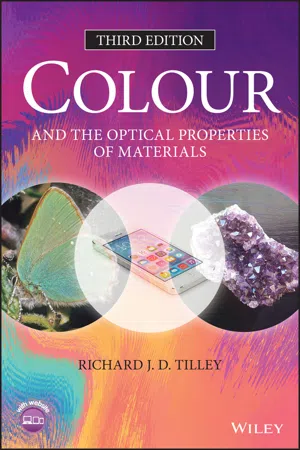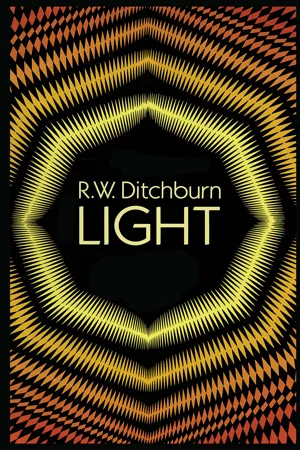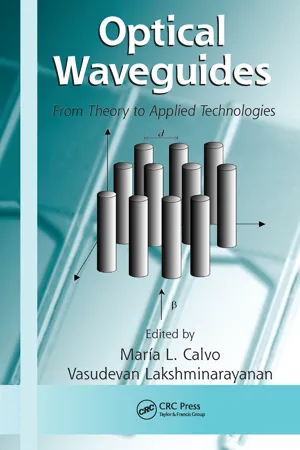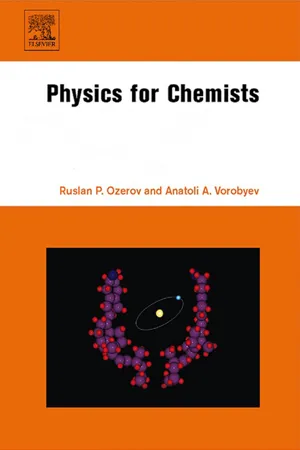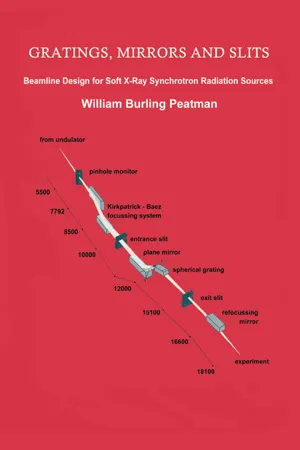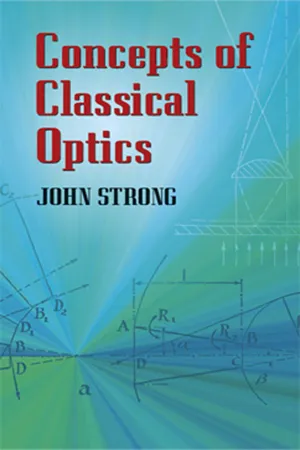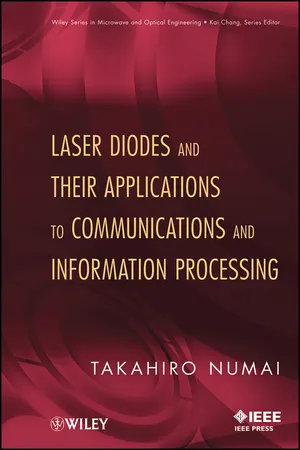Physics
Diffraction Gratings
Diffraction gratings are optical components with a series of closely spaced, parallel slits or grooves that diffract light. When light passes through a diffraction grating, it is dispersed into its component wavelengths, creating a spectrum. This dispersion property makes diffraction gratings useful in spectroscopy and other applications where precise wavelength separation is required.
Written by Perlego with AI-assistance
Related key terms
11 Key excerpts on "Diffraction Gratings"
- eBook - ePub
- Richard J. D. Tilley(Author)
- 2019(Publication Date)
- Wiley(Publisher)
A transmission diffraction grating made up of a series of transparent apertures in an opaque material produces its effect by selectively changing the amplitude of the light passing through it and is known as an amplitude object and specifically an amplitude grating. Suppose, instead, that the grating is composed of adjacent strips of material that are transparent but of differing refractive indices. In this case, a phase difference will be selectively introduced between the beams traversing adjacent regions, and the material is known as a phase object or phase grating. Differences in phase are not visible, but can be transformed into visible intensity differences using wave recombination techniques such as interference. Reflection gratings can also alter the amplitude or phase of the interfering beams to form amplitude and phase objects. It is diffraction that often sets a limit to the performance of optical instruments, including the eye, and the topic is therefore of particular practical importance. As well as allowing a quantitative analysis of the performance of optical instruments to be made, the mathematical analysis of diffraction lead to the production of Diffraction Gratings for use in spectroscopy and the understanding of crystal structures, thus providing the foundations of much of modern science. More recently diffraction studies have expanded into areas in which disorder, partial order, or sub-wavelength order, are dominant. These have important consequences – in explaining the transparency of the cornea of the eye, for example. The diffraction patterns formed by diffracting centres are sensitive to the wavelength of the incident light. When white light is involved a multiplicity of such patterns form. When these are spatially separated, intense colours can be observed. Commonplace examples of this abound. Diffraction effects contribute to the shifting colours seen on many multicoloured wrapping paper and bags - eBook - ePub
Laser Safety
Tools and Training, Second Edition
- Ken Barat(Author)
- 2017(Publication Date)
- CRC Press(Publisher)
7 Diffraction Gratings for High-Intensity Laser Applications Jerald A. BrittenIntroduction
The scattering of light into wavelength-dependent discrete directions (orders) by a device exhibiting a periodic modulation of a physical attribute on a spatial scale similar to the wavelength of light has been the subject of study for over 200 years. Such a device is called a diffraction grating. Practical applications of Diffraction Gratings, mainly for spectroscopy, have been around for over 100 years. The importance of Diffraction Gratings in spectroscopy for the measurement of myriad properties of matter can hardly be overestimated. Since the advent of coherent light sources (lasers) in the 1960s, applications of Diffraction Gratings in spectroscopy have been further exploded. Lasers have opened a vast application space for gratings, and apace, gratings have enabled entirely new classes of laser systems.Excellent reviews of the history, fundamental properties, applications, and manufacturing techniques of Diffraction Gratings up to the time of their publication can be found in the books by Hutley (1982) and more recently by Loewen and Popov (1997). The limited scope of this chapter can hardly do justice to such a comprehensive subject, so the focus here is narrowly limited to characteristics required for gratings suitable for high-power laser applications and methods to fabricate them. A particular area of emphasis is maximally efficient large-aperture gratings for short-pulse laser generation.Light of a wavelength λ incident at angle θi on a diffraction grating that has modulation with a period p is diffracted in a direction θm according to the grating equation:where m is the grating order. Figure 7.1 illustrates the geometry of diffraction of light of a single wavelength into various orders from a grating.Gratings can operate in transmission, reflection, or both. The modulation can be in the form of periodic variations in the density or refractive index throughout the bulk of a material. These are volume gratings. Or, the modulation can be physical corrugations of the surface of a material; these are surface relief gratings. - eBook - ePub
- R. W. Ditchburn(Author)
- 2013(Publication Date)
- Dover Publications(Publisher)
Thus in each case the centre of the diffraction pattern lies in the direction predicted by the ordinary laws of rectilinear propagation, of reflection and of refraction. The theory of diffraction thus includes these laws as limiting relations, valid for indefinitely wide beams.6.27. Diffraction Gratings.Any regular arrangement of similar apertures constitutes a diffraction grating, but one particular type of diffraction grating is of special importance in optics. This grating consists of a series of parallel lines ruled on glass or metal and spaced at equal intervals. A simple grating of this type may be made by covering a glass plate with an opaque layer of silver and then ruling parallel lines in the silver. The silver is removed by the needle, and clear spaces are left. This method produces a grating in which the clear spaces have a very high transmission, while the opaque spaces have nearly zero transmission, provided that the lines are not too close. Following the procedure explained in § 6.25 and substituting (k1 — k2 ) for κy in equation 6(35) , we havewhere 2d is the width of a clear space and 2e is the distance between the centres of two consecutive clear spaces.We may write 6(55) in the formwheref(U) is the factor depending on the shape of the individual aperture (now defined by a single parameter 2d) and F(NW) represents the factor depending on the arrangement of the apertures (i.e. the unit of separation, 2e). From the point of view adopted in § 6.8 , 2U is the difference of phase between wavelets from two sides of the same line, and 2W is the difference of phase between wavelets from the centres of two successive lines.6.28. The Functions f(U) and F(NW).These two functions are of fundamental importance in connection with the theory of the diffraction grating and also in other problems. The first appears whenever we sum a series of elements of constant amplitude with continuously and uniformly increasing phase. The second appears when we sum a number of elements of equal amplitude whose phases vary discontinuously in uniform steps. f(U) represents a limiting form to which F(NW) tends when N becomes indefinitely large. It is convenient to consider the two functions together. They are shown graphically in fig. 6.9 . Both functions are essentially positive, and both have a central maximum equal to unity when U or W = 0, together with a series of side maxima and minima. It is in relation to these side maxima and minima that they differ. f(U) is zero when U = mπ (if m is integral and not equal to zero), and it has a series of maxima approximately half-way between any two successive zero values. These maxima rapidly decrease in magnitude as we go away from the centre of the pattern [Example 6(vi) , p. 190]. About 93 per cent of the area below the curve lies within the region between the two central zeroes. F(NW) has two types of maxima. The first occur when W = mπ (m having any integral value including zero). At these points F(NW) = 1. These are known as principal maxima. F(NW) has also a series of subsidiary maxima flanking each of the principal maxima. The magnitudes of these maxima are small except for those near to the principal maxima. f(U) differs from F(NW) chiefly in that the former has only one principal maximum. The positions of the maxima and minima of these functions are summarized in Table 6.2 - eBook - ePub
Optical Waveguides
From Theory to Applied Technologies
- María L. Calvo, Vasudevan Lakshminarayanan(Authors)
- 2018(Publication Date)
- CRC Press(Publisher)
Consider light incident on a grating surface as shown in Figure 5.1a. We assume the incident light is an optical mode guided in the slab waveguide (see Figure 5.2a) of effective index n eff, and the grating is formed through the waveguide layers in a direction perpendicular to the waveguide plane. Most of the arguments to follow apply also to free-space gratings. Each grating facet represents a small source reflecting and transmitting incident light according the laws of reflection and refraction, and simultaneously acts as a narrow diffraction slit, thus determining the envelope of the far-field diffraction pattern, also called the slit function SF (Figure 5.1b). FIGURE 5.1 a) Diffraction grating schematics in reflection geometry. b) Far field intensity distribution of the light diffracted by a grating. c) Echelle grating used in near-Littrow incidence; the electric field directions of the TE and TM polarizations are indicated; RF and NRF are reflecting and non-reflecting facets, respectively. d) Blazed diffraction grating. Gratings are often used in reflection geometry with the grating surface typically covered by a reflective metal layer so that each facet acts as a small mirror. The light reflected by different facets will add in phase, hence producing interference maxima in those directions θ for which the phase difference between the light diffracted by two adjacent facets is 2πm, as expressed by the grating equation : * FIGURE 5.2 Examples of different types of optical waveguides - eBook - ePub
- C.R. Kitchin(Author)
- 2020(Publication Date)
- CRC Press(Publisher)
Figure 4.24 and the discussion later in this section).A practical device for producing spectra by diffraction uses a large number of closely spaced, parallel, narrow slits or grooves and is called a ‘diffraction grating’. Typical gratings for astronomical use have between 100 and 1,000 grooves per millimetre and 1,000–50,000 grooves in total. They are used at orders ranging from one up to 200 or so. Thus, the spectral resolutions range from 102 to 105 . Although the previous discussion was based upon the use of clear apertures, a narrow plane mirror can replace each aperture without altering the results. So, Diffraction Gratings can be used either in transmission or reflection modes. Most astronomical spectroscopes are in fact based upon reflection gratings. Often the grating is inclined to the incoming beam of light, but this changes the discussion only marginally. There is a constant term, d sin i, added to the path differences, where i is the angle made by the incoming beam with the normal to the grating. The whole image (Figure 4.3 ) is shifted at an angular distance i along the image plane. Equation 4.13 then becomes
and in this form is often called the ‘grating equation’.θ =sin− 1[](− sin i)m λd(4.24) Volume phase holographic gratings (VPHGs) are now used within many astronomical spectroscopes. These have a grating in the form of a layer of gelatine within which the refractive index changes (Section 4.2 ), with the lines of the grating produced by regions of differing refractive indices. The VPHGs operate through Bragg diffraction (Section 1.3 , Figure 1.97 and Equation 1.85 - eBook - ePub
- Ruslan P. Ozerov, Anatoli A. Vorobyev(Authors)
- 2007(Publication Date)
- Elsevier Science(Publisher)
b where, for clarity, spectra of different orders are given on a different vertical level. It can be seen that spectra of zero-, first- and second-orders exist separately, whereas spectra of the third- and fourth-orders are partially overlapped.Notice that a diffraction grating can also be used in a reflecting position.6.3.4 Diffraction grating as a spectral instrument
Spectroscopy is the method of studying the composition and structure of a substance or the control of technological processes (refer to Chapter 7 , Section 7.8 ). The main stage in spectroscopy is the decomposition of electromagnetic radiation in a spectrum on the wavelength or frequency. Optical spectroscopy deals with the optical range of electromagnetic radiation, including UV and IR. The basic units of optical spectrometers are either a prism or a diffraction grating.The most important characteristics of the quality of a spectral device are dispersion D and resolution R . Distinguish an angular and linear dispersion. The value numerically equal to the ratio of the angular distance between spectral lines δφ to the difference of wavelengths δλ of these spectral lines is referred to as angular dispersion. The angular dispersion is equal(6.3.5)D φ=,δ φδ λ(6.3.5)In order to obtain an expression for angular dispersion, we should find a derivative dφ /dλ from eq. (6.3.4) and change further the differentials into finite increments (neglecting the minus sign). At small angles, eq. (6.3.4) can be rewritten as bφ ≈ mλ - eBook - ePub
Gratings, Mirrors and Slits
Beamline Design for Soft X-Ray Synchrotron Radiation Sources
- WB Peatman(Author)
- 2018(Publication Date)
- Routledge(Publisher)
In order to address these points some knowledge of grating theory is required. For this, detailed calculations and ray traces will be an essential help. Equally important, a knowledge of the use for which the monochromator is to be designed is required. As already emphasized, the end users should be brought into the picture at an early stage of designing the beamline.4.2 THEORY OF CONVENTIONAL DIFFRACTON GRATINGSAs seen in chapter 3 , Fermat’s principle of least time explains the behavior of optical systems. There a mirror system was described and the optical path function defined. In the case of a diffraction grating, the phase advance of the radiation which occurs at the grating must be included in the optical path function: Nkλω. Here we develop the corresponding terms for straight ruled, constant spacing Diffraction Gratings.For a diffraction grating, light coming from point A (figure 4.2.1 ) and impinging on an arbitrary point P (ξ, ω, ℓ) on a grating will contribute to an image at B only if the optical path, F, is an extremum whereF =AP ¯+PB ¯+ Nkλωwhere N is the line density k is the order of diffraction ± 1, ± 2 etc. λ is the wavelength of the light being diffracted and ω is the position in the dispersion plane. The last term is due to the diffraction at the grating and has to be inserted in the optical path function “by hand”. If Fermat’s principle of least time is fulfilled, rays of light coming from A will arrive at B with the same phase, yielding constructive interference and hence, an image. According to Rayleigh’s criterion for constructive interference, ΔF ≤ λ/4. That is, there is a certain bandpass associated with the optical path function, a fact which we will not pursue here any further.The development is otherwise as shown in chapter 3 : i.e. the conditions for focussing A at B are given by= 0 and∂ F∂ ω= 0.∂ F∂ ℓA point in the image plane for which the derivative of the path function with respect to ω is zero is called a meridional focus. This is the dispersion plane of the grating and is the critical one for energy resolution. In the second case above, where the derivative with respect to ℓ - eBook - ePub
- M. Francon, N. Krauzman, J.P. Mathieu, M. May(Authors)
- 2022(Publication Date)
- CRC Press(Publisher)
F is placed against the condenser. It is parallel to the lines of the grating.Distance between F and L: about 90 cm.Distance between L and R: the grating R is placed at S′.Distance between R and E: the light reflected by the grating passes again through the lens L. This lens forms an image F′ of Fat a distance of about 4 m. The screen is placed at F′.9.5.3 Usage of a grating
The relation (9.4) can be satisfied for K = 1 only when λ < 2a. Thus for a grating of a given period, there exists a maximal wavelength above which the light will not appear in the first order spectrum. But a grating with a period very much greater than λ, can be used under grazing incidence. It is in this way that a grating made for the visible region can be employed for diffracting X-rays. The following experiment gives an analogy of this process. A slit placed against a mercury vapour lamp illuminates a metallic scale graduated in millimetres. When the incidence is nearly grazing, the spectrum of the source is observed in the reflected light.9.6 A CROSS-RULED SCREEN IN WHITE LIGHT
9.6.1 Principle
A cross-ruled screen is a two dimensional grating. In the set up of figure 9.15, the slit source is replaced by a circular hole and the line grating by a two dimensional grating of square mesh of side b. The diffraction pattern consists of an ensemble of images the centers of which form a grating of square mesh with side proportional to 1/b. The relative intensities of various images are represented by the diameter of the circles on figure 9.16 . In white light, each image is replaced by a spectrum.Figure 9.169.6.2 Setting up the experiment (fig. 9.17 )
Figure 9.17a) Apparatus
S: carbon arc.C: ordinary condenser.D: diaphragm with holes of different diameters.T: ordinary crossed grating or fine muslin or silk streched in a frame so that the threads remain straight. One may use two line gratings with period of 20 μ or 30 μ - eBook - ePub
Microoptics Technology
Fabrication and Applications of Lens Arrays and Devices
- Nicholas F. Borrelli(Author)
- 2017(Publication Date)
- CRC Press(Publisher)
In Sec. 4.1.3, we discussed the physical basis of Diffraction Gratings from the viewpoint of a surface relief pattern providing the periodic phase difference. This is certainly one primary way that Diffraction Gratings can be made. However, there is a much more general description of Diffraction Gratings of which the surface relief type is a special case. Actually, the underlying parameter of significance in a grating is the phase difference. This pattern can be produced in several ways, which we express as follows:Δ ϕ( x )=∑ mΔϕcos0 m()2 π m xΛ ( 7.1 )Here, A represents the grating period, the phase Φ is expressed in waves, Φ = nZ /λ where n is the refractive index and Z is the thickness. One can see the phase difference can be created either by letting Z vary with x in a periodic way, which would be the surface relief type, or by letting the refractive index vary in a similar way. The way we have written Eq. (7.1) amounts to a Fourier series; thus we are allowing a variety of functional forms of the way the phase can vary through a given period.Another useful way to classify gratings is by the characterization: thick and thin . The methods of making gratings (discussed later on) will clearly depend on what type of grating one wants to make; hence, this classification applies equally to the fabrication [1 ,4 ]. The distinction originates because the phase change of Eq. (7.1) can be accomplished with a small refractive index over a very long path. From a light-propagation standpoint, this represents a much different case and, as a matter of fact, is closer to the way one would deal with a waveguiding structure (see Ref. [2] in which this is referred to as the coupled mode treatment of gratings). On the other hand, if the grating were very thin, then small changes in the path length have little effect on the diffraction efficiency. Such a change might occur by a differing angle of incidence. This is in contrast to the thick example, in which very small changes in the path length have a very large effect on the diffraction efficiency. So much so, that in the thick limit the efficient diffraction occurs at only one angle of incidence. This angle is called the Bragg angle . A number of gratings are schematically shown in Fig. 7.1. - eBook - ePub
- John Strong(Author)
- 2012(Publication Date)
- Dover Publications(Publisher)
, we getTranslating this angle to δλ R , we get the resolving power of the so-called transmission amplitude grating at normal incidence,10-6. Diffraction GratingsA set of multiple slits constitutes an amplitude transmission grating, but such a set is not very useful as a grating because it is impossible to make the elements—alternate openings and obscurations—fine enough. In Diffraction Gratings it is desirable to have up to 30,000 diffracting elements per inch.Our treatment of § 10-3 may be applied directly to an amplitude grating, where the amplitude is modulated across the wave front. It also applies to the more common grating, the phase grating, where phase is modulated across the wave front, and where the amplitude is only slightly modulated, if at all. There are two general subtypes of each of these two types: transmission gratings and reflection gratings . Reflection gratings are almost always phase grattings ; they are made by embossing equal parallel straight grooves on a smooth metal surface, by means of the sharp diamond point of a ruling engine. A replica of such an embossed surface on one side of a transparent plate can be used as a transmission phase grating.Transmission phase gratings may be explained by consideration of the Huygens wave trainlets from our familiar set of multiple slits. Let the slit separations be a, as before, with the k th order of interference occurring at . We consider each one of the openings now divided into m equal sub-strips, which are in juxtaposition as is illustrated in Fig. 10-12 . Furthermore, at first, let us consider that the width of each slit is equal to the separation a . Then the m complex numbers, representing the m Huygens wavelets from the m sub-strips, of which our separate slits of width a are each comprised, will add as vectors in the complex plane to form a complete circle (just as they do in the case of two adjacent half-period Fresnel zones in Fig. 9-2 b). The vector resultant of a circle of m vectors is, of course, zero. Thus this particular set of multiple slits, each of width a, can only give an interference pattern of zero amplitude in the direction α. This amplitude is zero because in fact we do not have a grating at all, but only a clear aperture of width . This particular grating, which is really here only an open window, becomes an ideal amplitude grating if the near half, say, of the m vectors for each set of sub-strips is eliminated by obstructions. Then the vector resultant of the remainder becomes the diameter of our aforementioned circle of m vectors. But even better, our imaginary grating becomes an ideal phase grating, for the direction α , when we add a suitable tiny transparent prism to each slit of width a. The prisms are suitable when they introduce a progressive phase retardation (N − 1)d which varies from zero, for the farthest of the m sub-strip wavelets of each slit, to (N − 1)d = kλ, for those that are nearest. This progressive phase retardation transforms our circle of m vectors, one vector for each sub-strip, into a straight line of m vectors. Thus the length of the vector resultant, which was first zero for the full circle and then the circle diameter, becomes the circle circumference—the m - Takahiro Numai(Author)
- 2011(Publication Date)
- Wiley-IEEE Press(Publisher)
The oscillation wavelength for the light sources of optical fiber transmission systems is 1.3 μ m, in which dispersion of non-dispersion-shifted optical fiber is the lowest, or 1.55 μ m, in which the absorption loss of an optical fiber is the lowest. Because the effective refractive index n r0 of LDs is nearly 3.2, pitches of the first-order grating Λ are approximately 0.2 μ m for an oscillation wavelength of 1.3 μ m and 0.24 μ m for an oscillation wavelength of 1.55 μ m from (4.42). The corrugation depth is about 0.1 μ m = 100 nm just after grating fabrication and is reduced to several tens of nanometers after the epitaxial growth of semiconductor layers on diffraction grating, due to thermal decomposition of the grating surface during heating prior to epitaxial growth. To fabricate such fine Diffraction Gratings with high accuracy, holographic exposure [8–16], electron beam exposure [8–17], and x-ray exposure [8–18] systems have been developed. Holographic Exposure In holographic exposure, interference of two coherent laser beams is used to generate interference fringe patterns. The interference fringe patterns obtained are transferred to the photoresist coated on the substrate via developing the photoresists. Finally, the substrate is etched with a patterned photoresist as the etching mask. Figure 4.21 shows the principle of holographic exposure, where solid lines show wave fronts of two lightwaves and filled circles represent points at which the light intensity is enhanced due to interference. When wave fronts propagate toward the substrate, filled circles connected by dashed lines end in arrows
Index pages curate the most relevant extracts from our library of academic textbooks. They’ve been created using an in-house natural language model (NLM), each adding context and meaning to key research topics.
